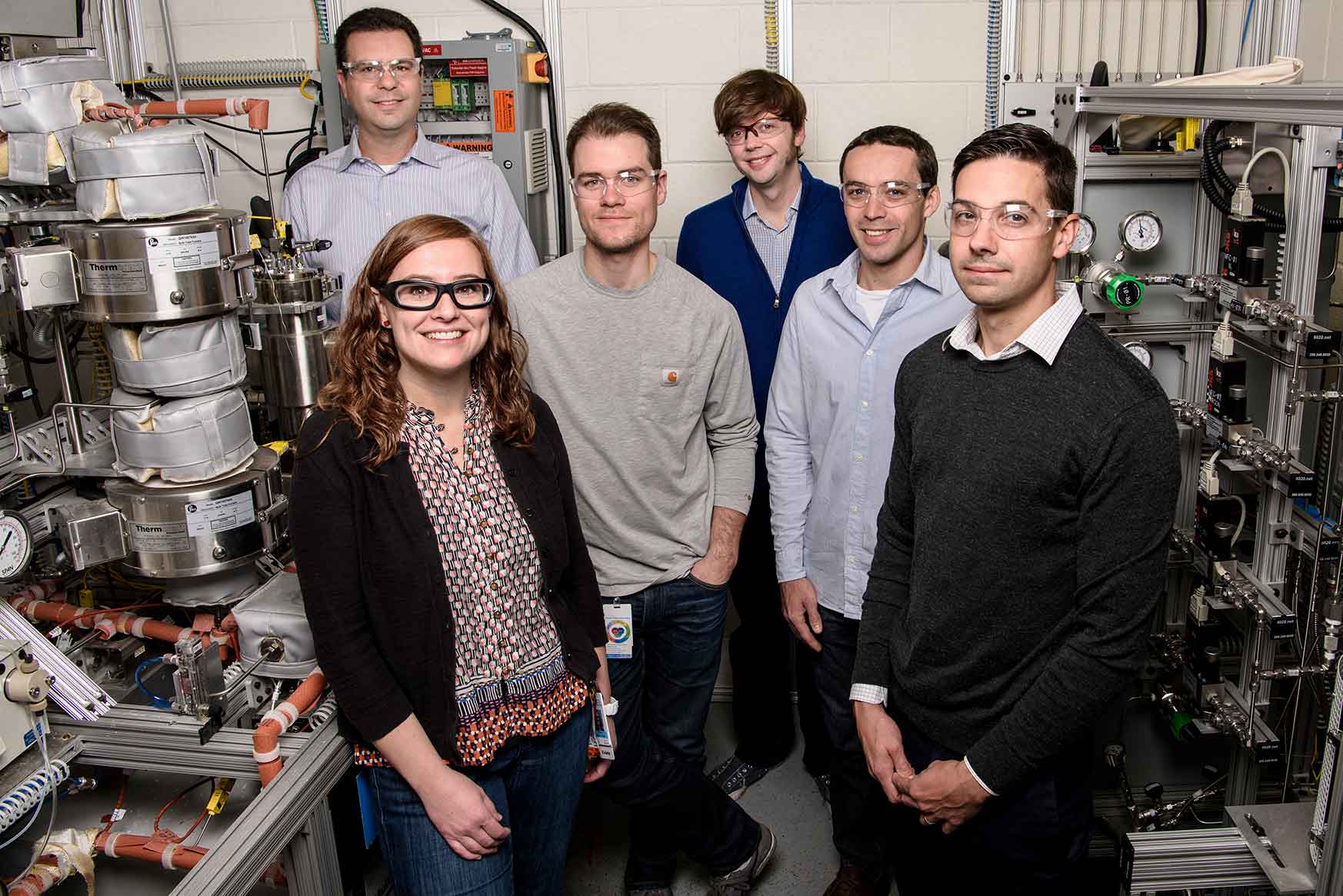News Release: NREL Develops Novel Method to Produce Renewable Acrylonitrile
A new study from the Energy Department’s National Renewable Energy Laboratory (NREL) establishes a novel catalytic method to produce renewable acrylonitrile using 3-hydroxypropionic acid (3-HP), which can be biologically produced from sugars. This hybrid biological-catalytic process offers an alternative to the conventional petrochemical production method and achieves unprecedented acrylonitrile yields.
Acrylonitrile, a petroleum-derived commodity chemical, is one of the most widely used monomers in the chemical industry with many commercial applications. Today, acrylonitrile is used in the production of acrylic fibers for carpets, clothes, and fabrics, and in plastics such as food containers, and packaging materials. Most importantly for this project, acrylonitrile is also the primary building block in carbon fiber composites, which are used for lightweighting applications in automotive and air transportation. Acrylonitrile is produced today industrially via an energy-intensive and chemically hazardous process.

Pictured from left to right are Adam Bratis, Violeta Sànchez i Nogué, Todd Eaton, Gregg Beckham, Vassili Vorotnikov, and Eric Karp, part of the NREL team working on a cost-competitive, sustainable process for creating acrylonitrile and carbon fibers from renewable biomass. (Photo by Dennis Schroeder / NREL)
Propylene price volatility and environmental sustainability have motivated a search for alternative pathways using bio-derived feedstocks such as glycerol and glutamic acid. Yet none have been able to compete with the traditional process in terms of cost and yield. Now, new NREL research is showing promise toward achieving this goal.
Newly published in Science, “Renewable Acrylonitrile Production” shows a path toward a cost-effective, bio-based acrylonitrile manufacturing process. Researchers were able to achieve a 98% yield of acrylonitrile using a new, robust catalytic process. Based on yields alone, this is a very important discovery: in comparison, after six decades of commercial-scale improvements and optimization, the traditional acrylonitrile production process achieves yields of approximately 80%–83%.
“The high acrylonitrile yield allows us to propose a potential industrial process for the conversion of lignocellulosic biomass to renewable acrylonitrile and carbon fibers,” said Gregg Beckham, group leader at NREL and senior author of the study. “Historically, acrylonitrile prices have been volatile due to ties to propylene prices. This alternative manufacturing process, one that relies on renewably sourced feedstocks, could help stabilize acrylonitrile prices and lead to broader market adoption of carbon fiber-based materials. This is an important step forward for lightweighting transportation applications, thus creating significant cost savings for transportation, as well as reducing our impact on the environment.”
In addition to the high yields, this new approach has multiple benefits over the current petroleum-based acrylonitrile production process. The new process eliminates production of hydrogen cyanide—a toxic side product—uses a simpler and less expensive catalyst, and could be done in a simpler reactor configuration. Moreover, this new high-yield process can utilize non-food biomass, such as agricultural wastes, as a feedstock instead of propylene.
“We are excited about the prospects of this new chemistry for acrylonitrile production to ultimately enable the production of renewably sourced carbon fibers,” said NREL Associate Laboratory Director Adam Bratis and principal investigator of the NREL-led Renewable Carbon Fiber Consortium. This groundbreaking research is the result of an interdisciplinary collaboration of researchers across chemical engineering, biology, and computational modeling, including NREL authors Eric Karp, Todd Eaton, Violeta Sànchez i Nogué, and Vassili Vorotnikov, as well as other contributors from NREL, the University of Colorado Boulder, Johnson Matthey, and the Mid-Atlantic Technology, Research & Innovation Center.
NREL estimates the new process could put the selling price of biomass-derived acrylonitrile below $1 per pound from cellulosic biomass or starch-based sugars. A $1 per pound target was deemed necessary for cost competitiveness with conventionally produced acrylonitrile.
Driven in part by the interest in using carbon fiber for lightweighting vehicles and aircraft that will save money on fuel costs, the demand for carbon fibers is projected to increase 11% to 18% annually. And given that the carbon fiber industry is especially sensitive to price fluctuations in their base chemical acrylonitrile (it takes roughly 2 pounds of acrylonitrile to generate 1 pound of carbon fiber), there is a clear need to develop alternative cost-competitive processes. In the past, propylene price volatility and environmental sustainability within composites production have motivated the search for alternative approaches to propylene ammoxidation to produce acrylonitrile. With the process described in this work, NREL researchers are one step closer to this goal.
The work reported in Science was funded by the Energy Department’s Bioenergy Technologies Office. An international patent application has been filed on this research, and the NREL Technology Transfer Office will be working with researchers to identify potential licensees of the technology.
NREL is the U.S. Department of Energy's primary national laboratory for renewable energy and energy efficiency research and development. NREL is operated for the Energy Department by The Alliance for Sustainable Energy, LLC.
Last Updated May 28, 2025
